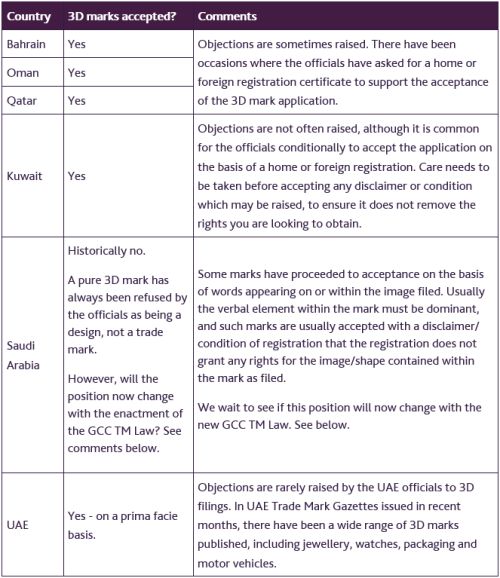As obtaining and enforcing three dimensional marks in Europe, the US and elsewhere becomes more and more difficult, what is the current landscape for three dimensional (3D) marks in the Gulf region? What does the future hold?
This is a question that is being raised more and more as the Gulf Co-Operation Council Trade Mark Law (the GCC TM Law) is enacted through the Gulf Co-Operation countries (Bahrain, Kuwait, Oman, Qatar, Saudi Arabia and the UAE).
The question also arises due to the inadequacies particularly in registered design protection, as rights holders look to non-traditional trade marks alongside or in lieu of design protection.
The GCC TM Law
The new GCC TM Law is aimed at unifying trade mark law across the six GCC member states. It is already in force in Bahrain, Kuwait and most recently, Saudi Arabia as of late September 2016.
It is yet to be enacted in Oman, Qatar and the UAE and to date there are no indications of likely implementation dates.
The definition of a trade mark is broadened considerably beyond what was, or is, contained within national laws. Under the GCC TM Law, a trade mark is explicitly defined as being able to consist of shapes or figurative elements, as well as colour.
There is still scope for national interpretation of laws. The GCC Council has made provisions for the Committee of Commercial Cooperation (CCC) to have the right to interpret the GCC TM Law and propose amendments to the law. However, the GCC TM Law does not specify whether National offices are able to refer questions to the CCC, or whether users of the system are able to make referrals.
We may find that some national offices will proceed with their own interpretation of the laws until, or unless, the CCC hands down its interpretation of aspects of the law. This could mean that some offices will simply follow existing practices until the interpretation is handed down from theCCC.
We wait to see whether countries, such as Saudi Arabia, which to date have taken a very conservative approach to 3D marks and non-traditional marks, will look positively on such applications under the new law.
Alternative to designs
Delays and/or inadequacies in registered design protection and enforcement of such rights have meant that rights holders are looking to alternative forms of protection for products / product packaging.
It is also a region where registered rights are important for enforcement. With a delay of many years to obtain a design registration, a non-traditional mark, if registered, offers rights holders a far greater chance of removing an infringing product in the absence of registered design protection.
In recent years, infringements in the region are becoming more and more sophisticated. There has been an increase in look-a-like products and so rights holders are looking to boost their portfolios in order to take action.
Rights holders are therefore looking increasingly to non-traditional marks, such as shape marks, for this additional protection. If protection is obtained as a trade mark, it also offers the added benefit of outlasting a design registration by many years.
That said, practice regarding 3D trade marks can vary across the Gulf countries. For example, the neighbouring countries of the UAE and Saudi have been at either ends of the spectrum. 3D marks are accepted prima facie in the UAE, whereas it is has been all but impossible to secure protection for 3D trade marks in Saudi Arabia.
The table below provides a snap-shot of the current position for the GCC countries:

As can be seen from the table, in some countries in the region, rights holders are more likely to obtain 3D mark registrations on a relatively straightforward basis, than may be the case in other regions such as Europe.
Practical challenges
When filing for shape marks or other non-traditional marks, it is important to ensure that the registrations you obtain actually cover the elements you are looking to protect.
Some practical issues can unexpectedly limit your rights and/or make any resulting registration all but worthless. With the recent increases in filing fees in the region, it can mean significant costs being wasted if the application does not provide the protection you were hoping for.
The first challenge an applicant is likely to face is one of space. Trade mark representations have to be contained within a defined space (usually around 6cm by 6cm). The representation cannot go beyond this. Applicants have very limited space within which to depict the mark and ensure the relevant aspects of the trade mark are visible. It can also mean having to choose a limited number of views of the shape, rather than the usual seven or so views commonly used in 3D filings elsewhere.
Also, unlike other countries, there is no box on the forms to state that the mark applied for is a 3D mark. It is therefore important to ensure this is expressed in any mark description, to avoid the Trade Mark Office officials, or enforcement officials, from seeing any resulting registration as being an unusual looking logo.
Where a mark description can be included, rights holders should work closely with local advisors to ensure it clearly describes the mark and details that it is a 3D trade mark. Care will need to be taken drafting the description to ensure it does not unnecessarily limit protection.
There have been examples of past acceptances where the description does not protect the non-traditional trade mark applied for in the way the applicant may have expected. Colour-only marks have been accepted which actually describe the swatch of colour attached to the form, rather than the intended colour-only mark. Wording used has been along the lines of "a turquoise coloured square" as opposed to the colour per se. Similarly, three dimensional packaging marks have been described as "a rectangle made of lines" rather than being clearly described as a three dimensional mark for the shape of packaging.
Work locally
Non-traditional trade marks can provide you with registered rights that can be enforced in many gulf countries. However, it is important to work closely with local advisors to ensure you obtain rights that provide the required protection.
Working closely with local representatives should help to ensure that any resulting registration for three dimensional packaging or for another form of non-traditional mark will ultimately offer protection in the manner required, and will in turn offer protection for your products and product packaging.
The content of this article is intended to provide a general guide to the subject matter. Specialist advice should be sought about your specific circumstances.
